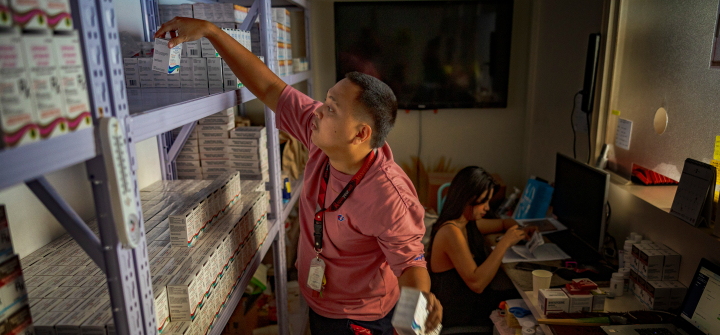The Danger of ‘America First’ in Global Health
The America First Global Health Strategy released last month presents a bold vision of U.S. leadership while overlooking the realities on the ground that determine whether lives are saved or lost. As health leaders with more than 40 years of collective experience in global health across multiple continents, we bring academic expertise and firsthand knowledge of how policies translate into practice. The administration’s new strategy seeks to position the U.S. as the world’s health leader yet disregards the realities in low- and middle-income countries. This leads to recommendations that, if implemented, would worsen the very problems the report seeks to solve.
A Narrow Definition of ‘Health Leader’
The strategy equates health leadership with dollars spent and medical products exported. By these metrics, the U.S. spends more than any other donor country. However, the U.S. health system consistently underperforms compared to other high-income nations, leaving Americans with the highest per-capita spending ($13,432 per person) but the lowest life expectancy (78.4 years) and the highest maternal mortality ratio (22 maternal deaths per 100,000 live births in 2022). Dollars alone do not equal better health.
Misdiagnosing Inefficiency and Dependency
The report correctly notes that U.S. foreign assistance programs are often inefficient, with duplicative systems, high overhead, and donor-driven priorities. These “phantom aid” problems are well documented by the global health community. The report also places blame on NGOs and foreign governments yet offers misguided solutions including privatization, conditional aid, and bilateral agreements. These proposals risk deepening inefficiency and dependency.
Tying aid to purchases from donor countries is a significant problem contributing to phantom aid, yet is a solution offered by the report. Conditional aid, in particular, misaligns priorities. Tying funding to U.S. economic objectives distorts priorities away from patient care and community need, causing inefficiency and lives lost. Promoting U.S. companies’ expensive products in markets that cannot sustain them will accelerate waste.
Ignoring the Broader Burden of Disease
The narrow focus on infectious diseases like HIV, TB, malaria, and polio reflects yesterday’s battles, not today’s realities. Analysis of the global burden of diseases reveals that infectious disease represents less than a third of the global burden of disease. Non-communicable diseases, maternal and infant mortality, surgical access, and the looming health threats of climate change all demand more urgent attention.
Missing the Power of Soft Diplomacy
The report overlooks the pivotal role of soft diplomacy yet concedes that programs like PEPFAR and smallpox eradication did more than save lives. They built goodwill, strengthened alliances, and created platforms for long-term partnership. In an era of geopolitical rivalry, relationships built through training exchanges, joint research, and genuine capacity building enhance U.S. credibility abroad. By sidelining this diplomatic power, the strategy risks eroding one of America’s most effective tools of influence.
Multilateralism, not Isolationism
We are most concerned by the strategy’s retreat from multilateralism. Global health crises cannot be contained through a patchwork of bilateral agreements. Outbreaks demand cooperative, coordinated, multilateral responses rooted in trust and shared responsibility. Excluding global institutions and prioritizing “America First” undermines the very surveillance and containment goals the strategy claims to advance. Epidemics are not contained by political boundaries. They demand cooperation, trust, and collective action. Retreating from multilateral institutions undermines both U.S. security and global preparedness.
The Risk of Solutions Worse Than the Problems
The America First Global Health Strategy identifies real problems—waste, dependency, misalignment—but prescribes solutions that will only deepen them. Conditional aid, privatization, and self-interested bilateralism will magnify distrust and weaken already fragile health systems, the same systems at highest risk for disease outbreaks. By sidelining local expertise and ignoring the realities of health delivery in resource-limited settings, this strategy risks unraveling decades of progress.
If the U.S. truly wishes to lead, it should recommit to multilateralism, strengthen local systems through capacity building and education, and engage in genuine partnership while developing solutions that truly tackle inefficiencies and phantom aid. Otherwise, the problems outlined in the report will not be solved. They will be amplified. And America, along with the rest of the world, will be less safe.
Ana Maria Crawford, MD, MSc, is a clinical professor and director of Global Engagement Strategy for the Department of Anesthesiology, Perioperative and Pain Medicine at Stanford University.
Michele Barry, MD, is the director of the Center for Innovation in Global Health and senior associate dean for Global Health at Stanford University.
Join the 50,000+ subscribers in 170+ countries who rely on Global Health NOW summaries and exclusive articles for the latest public health news. Sign up for our free weekday newsletter, and please share the link with friends and colleagues.
A pharmacist stocks PrEP medicine at a pharmacy in a community center operated by LoveYourself, a nonprofit impacted by the U.S. administration's freeze on foreign aid, on February 19, 2025, in Mandaluyong, Metro Manila, Philippines. Ezra Acayan/Getty Images






